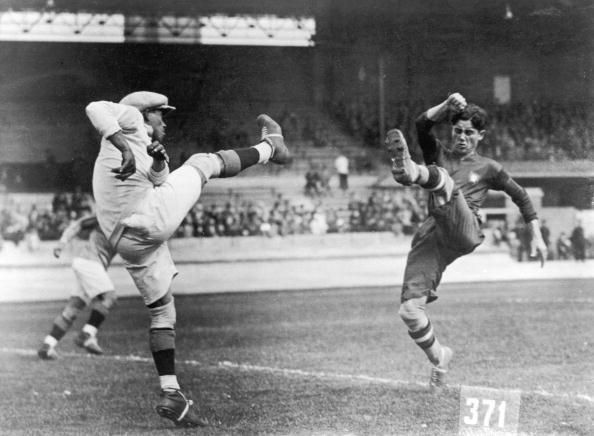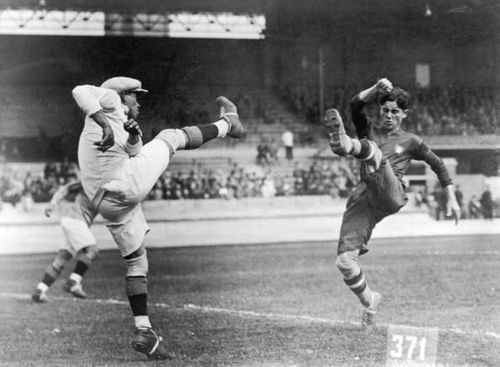
Football at the Olympics - The Story of the World Cup before it became the World Cup

The first international football match was played at Hamilton Crescent, the home of the West of Scotland Cricket Club, on November 30th 1872. Scotland and England played out a 0-0 draw, a scoreline made remarkable by the 2-2-6 and 1-1-8 formations on show. To be fair to them it would be the only 0-0 they contested until 1970, with 85 games in between.
Scotland had come the closest to hitting the back of the net (although it would be nearly 20 years before nets actually started being used) when the referee disallowed a goal which he adjudged to have cleared the tape. What tape? I hear you ask. Well, that would be the tape that was used in place of a crossbar. If only they’d had VAR in the 19th century (and the ability to connect two parallel metal poles with some sort of perpendicular metal pole).
Wales soon decided that they wanted in on the action, and were quickly followed by Ireland, who in 1883 completed the line-up for the first Home Nations Championship. Scotland beat England 1-0 with a goal from John Smith (yes, that John Smith) to claim the inaugural title.
For nearly 50 years this was considered to be the premier international football tournament in the world, until 1930 when Uruguay hosted and won the first World Cup. However, none of the home nations designed to enter, under the proviso that it was not up to their standard, which is a shame, because if they were as good as they said they were, they would have had a great chance of winning.
Either way, international football had been going for 58 years by 1930, and plenty of teams - from Argentina to Yugoslavia - had had teams since before or around the turn of the century. Indeed Fifa had been founded in 1904, but it had it taken them 26 years to create a worldwide competition. Fortunately for them, another institution had stepped up to the plate and been running major international tournaments for the beautiful game since 1900.
Football at the Olympics was typically limited to amateur players (though there was some blurriness regarding the definition of amateur) so it maybe wasn’t an indication of the true strength of the game, but given that Uruguay won consecutive gold medals leading up to their world cup triumph, it likely gave some indication of where the power lay. And up until 1930, it was the only opportunity for fans to support their teams against sides from all over the world, so it would still have had meaning invested in it.
The first tournament was nominally won by Great Britain, beating France and Belgium into silver and bronze. I say nominally because at the time no medals were handed out (the IOC now officially recognises the podium though) and only two matches were played. Britain thumped France 4-0, and they then thumped Belgium 6-2. I don’t know why that meant that Britain got the gold, seeing as the tournament was likely planned as an exhibition, with France also scheduled to play Switzerland and Germany, who never made the trip, but they did.
I also say nominally because the three teams weren’t really proper national sides either. Britain were represented by Upton Park FC, a club side who participated in the first ever FA Cup. The French team was formed by the USFSA, an amateur sports governing body, who would go on to enter a team designated France B along with another French team called France A in the 1908 Olympics. The Belgian team is listed as the University of Brussels, although the University archivist denies that they sent the team, and the squad did comprise of players from a number of different Belgian clubs.
The 1904 competition was won by those footballing giants Canada, or should I say, by a club called Galt FC from Canada, who defeated handsomely two separate teams from the USA. Christian Brothers College and St Rose’s Parish then had to replay their match twice to determine where to send the Bronze and Silver medals.
Four years later was the first universally accepted tournament between genuine national sides. The first French side, France B, were knocked out in the quarter-finals 9-0 by Denmark, who then went on to thrash the France A side even heavier with Sophus Nielsen scoring 10 times for the Danes in a 17-1 semifinal win.
So shocked were the French by this defeat that they withdrew from their bronze medal match, allowing the previously knocked out Sweden a shot at the Netherlands, which they could not take. Despite their intimidating 28-1 goal difference, Denmark could not beat Britain in the final, who, to their credit, had also beaten Sweden 12-1 in the quarterfinals. And there you all were thinking 4-2 was an exciting scoreline.
The Stockholm tournament in 1912 featured many similar faces to the previous one, but a few new ones resulted in a record field of 11 teams (although Bohemia’s application was rejected for the second time in a row due to having no membership of FIFA), and the same three nations stood atop the medals podium, in the same order. This time Britain, captained again by Chelsea forward Vivian Woodward, who scored 29 goals in 23 games for the English national side, did beat Denmark 4-2 in the final.
For understandable reasons, there was no tournament in 1916, although Germany are said to have defeated a British side 3-2 in No Man's Land on Christmas Day 1914. However, no medals were handed out on that day.
Bohemia, under the new name of Czechoslovakia, were allowed to enter the 1920 event, but then suffered the ignominy of becoming the only side to have ever been disqualified in an international final when they walked off in the middle of the match against Belgium, in protest against what they viewed as shoddy officiating by the 65-year-old English referee.
For their part, the Belgian press had done their best to create a hostile atmosphere by portraying Czechoslovakia as one of the baddies in World War I, and Belgian fans then threatened the Czech players during a pitch invasion after the walk-off, so, all in all, there was a fair amount of chaos.
Because of their disqualification, Czechoslovakia were stripped not of the silver medal, but of their right to compete in a separate tournament for the silver medal. The format, devised by Swedish water polo player Erik Bergvall, was designed to make sure that the best three teams would theoretically get the three medals and to avoid a situation whereby the second best team would be knocked out in round one by the eventual winners and end up with nothing to show for it. Lewis Carroll, of Alice in Wonderland fame, also came up with a similar system for Wimbledon.
The four losing quarter-finalists would face off in two knockout rounds, and the winner of this tournament would go through to another four-team knockout, against the teams beaten by the gold medallists in round one, the semi-finals and final. As it happened, Belgium had received a bye in round one after Poland failed to show up due to the Soviet-Polish war (fair enough), so Czechoslovakia’s disqualification left only Spain (winners of the quarter-final loser KO) and the Netherlands (beaten semi finalists) to slog it out for silver and bronze. Spain won, giving the Netherlands their third consecutive bronze medal. Got it?
If you don’t then it doesn’t matter, because the format was scrapped for the following tournament, and never heard from again. Only 24 years after it had hosted its first games, Paris was the battleground for what is commonly accepted as the first true Worldwide football competition, with the inclusion of the USA and Uruguay. FIFA recognise it and the 1928 tournament as official competitions equivalent to a World Cup and allow the victors to display a star above their crest in the same manner as World Cup winners. It was so popular among fans that around a third of all income generated by the Olympics came from the football tournament.
Uruguay, having travelled across the Atlantic with third-class tickets, had toured Spain in the lead up to the tournament, and comfortably dispatched Yugoslavia 7-0 in their opening match. The previous year they had won the South American championships without losing a match to qualify.
Belgium, winners last time out, suffered an ignominious 8-1 loss to Sweden in the first round, afterwards mythologised as ‘Catastrophe de Colombes‘ by the national press. Silver medalists Spain, themselves were beaten only once in the 4 years since 1920, were dumped out by Italy thanks to an own goal. The Netherlands may have been thinking that this was finally their chance to improve on third place, but were knocked out by the South Americans due to a controversial penalty scored by Hector Scarone late in the game.
When a Dutch referee was appointed for the final the Uruguayans were understandably upset, and persuaded FIFA to reconsider, with a French replacement being drawn out of a hat. Switzerland, who had impressed on their way to the final, couldn’t match Uruguay’s passing game (which is described similarly to that of Pep Guardiola’s Barcelona) and succumbed to a 3-0 defeat. Uruguay became the first true champions of the world, a feat they would of course repeat in the inaugural World Cup 6 years later.
But first they had an Olympic title to defend, and defend it they did. A rematch against the Netherlands in round one proved nowhere near as stern a test, as the hosts were sent packing early on. South American representation had doubled with the addition of Argentina, who utterly devoured the United States 11-2 in their first competitive appearance on European soil, and they would follow it up with a slightly less monstrous 6-3 win over Belgium.
Italy required two games against Spain to make it through the quarterfinals but somehow transpired to win the rematch 7-1 after a one all draw the first time around. Egypt would also make the semi-finals following a 2-1 victory over Portugal, but they would lose 11-3 to Italy in the Bronze medal match, with no fewer than three Italian players scoring hat-tricks. All of which meant, quite predictably, that the two South American sides would face off for the Gold medal.
With over 250,000 people requesting tickets for the final, it was one of the most hotly anticipated matches in the history of the game. On June 10th the two sides played to a one-all draw after extra time, but they came back three days later (with no penalty shootouts a rematch was required) and this time Uruguay were able to snatch the victory, and with it their second straight Olympic Gold Medal.
A year later the FIFA Congress in Barcelona voted to award the hosting of the first World Cup to Uruguay. They didn’t disappoint, duly winning their third major tournament in a row, in front of home crowds.
Football wasn’t even included in the 1932 Olympics, in part due to the introduction of the World Cup and in part down to the American hosts wish to promote the up and coming sport of American football. It would make its return in 1936, but with the World Cup established as the premier international competition, the Olympics would lose its lustre.
And with the increase in professionalism of the sport, it became more and more difficult for nations to field their best players. So while the 1924 and 1928 tournaments can be viewed as effectively the first two World Cups, the Olympics in the years to come wouldn’t be quite so revered.